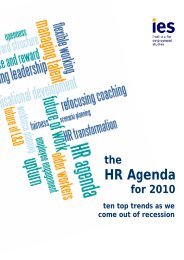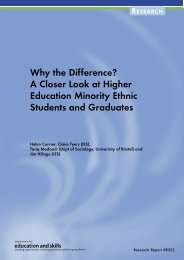Post-16 Transitions: a Longitudinal Study of Young People with ...
Post-16 Transitions: a Longitudinal Study of Young People with ...
Post-16 Transitions: a Longitudinal Study of Young People with ...
Create successful ePaper yourself
Turn your PDF publications into a flip-book with our unique Google optimized e-Paper software.
<strong>of</strong> work-related training schemes. In turn, this has meant<br />
finding ways <strong>of</strong> ensuring that these expanded forms <strong>of</strong><br />
provision could be funded and that young people had the<br />
financial means and incentives to pursue them. The current<br />
attempt to enable half <strong>of</strong> all young people to go to university<br />
(DfES, 2003c), therefore, can be seen as part <strong>of</strong> an ongoing<br />
programme for expanding the education and training<br />
pathways that can be traced back at least as far as the Youth<br />
Training Schemes <strong>of</strong> the 1980s.<br />
Second, governments have sought to make this expanded<br />
range <strong>of</strong> opportunities both coherent and progressive. This has<br />
involved, for instance, developing programmes and<br />
credentials (such as GNVQs) which straddle the educationtraining<br />
boundary and lowering the barriers between<br />
institutions in terms <strong>of</strong> the kinds <strong>of</strong> qualifications they can<br />
<strong>of</strong>fer and the extent to which qualifications are transferable<br />
between them. It has also involved ensuring that this more<br />
coherent system opens up pathways for young people which<br />
propel them towards higher levels <strong>of</strong> skills development and<br />
accreditation so that they are ultimately able to enter the<br />
labour market <strong>with</strong> a good prospect <strong>of</strong> finding employment.<br />
The clearest markers <strong>of</strong> these trends were, perhaps, the<br />
establishment <strong>of</strong> first the Further Education Funding Council<br />
in 1992 and then the Learning and Skills Council in 2000.<br />
Between them, these councils not only progressively brought<br />
the post-<strong>16</strong> sector under a single umbrella, but also ensured<br />
that funded provision in that sector was oriented towards<br />
accreditation and progression into the labour market. This<br />
agenda continues to be taken forward by the government’s 14-<br />
19 strategy (DfES, 2003a).<br />
Of particular significance from the point <strong>of</strong> view <strong>of</strong> young<br />
people <strong>with</strong> special educational needs was the establishment<br />
by the Learning and Skills Act 2000 <strong>of</strong> the Connexions Service.<br />
Within the context <strong>of</strong> a commitment to all young people, this<br />
new service is intended to have a clear focus on supporting the<br />
transition <strong>of</strong> those young people most at risk <strong>of</strong> ‘fractured’<br />
transitions and, moreover, <strong>of</strong> sustaining that support to a<br />
point in their lives where progression through education and<br />
training and into the labour market is likely to be a reality, for<br />
the majority at least. For most young people, this means that<br />
they will have access to Connexions between the ages <strong>of</strong> 13<br />
and 19, but for young people <strong>with</strong> learning difficulties and<br />
disabilities, support can be provided up to the age <strong>of</strong> 25.<br />
For individual young people (and particularly those <strong>with</strong> the<br />
greatest difficulties) Connexions is potentially an important<br />
element in ensuring that the new range <strong>of</strong> education and<br />
training opportunities cohere into genuinely progressive<br />
routes through the transition process. This study explores the<br />
<strong>Post</strong>-<strong>16</strong> <strong>Transitions</strong> <strong>of</strong> <strong>Young</strong> <strong>People</strong> <strong>with</strong> SEN: Wave 2 11

















